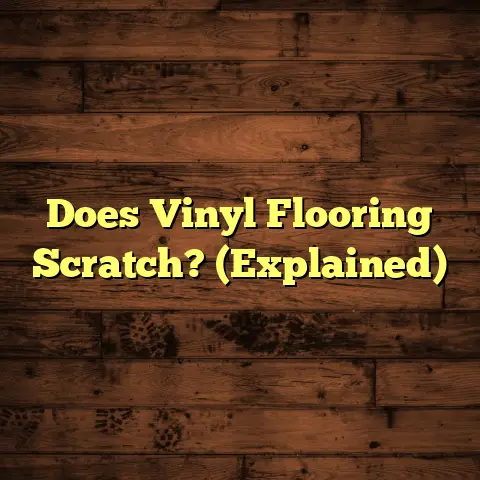Removing Glued Laminate Floors (4 Steps to Success!)
As the seasons change, so does our desire
to spruce up our homes, right?
With spring in the air, I’ve been getting
tons of questions about flooring projects.
One of the most common?
How to tackle those pesky glued laminate floors.
If you’re looking to update your space and
those old floors just aren’t cutting it anymore,
you’re in the right place!
Removing glued laminate might seem like a Herculean task, but trust me, with the right approach, it’s totally doable.
I’ve broken it down into four simple steps that I’ve used countless times in my own projects and with my clients.
In this article, I’m going to walk you through
the entire process, sharing my pro tips to
ensure your flooring removal is as smooth
and efficient as possible.
Let’s get started!
Step 1: Preparation and Tools Needed
Okay, before we start swinging hammers
and prying up planks, preparation is KEY.
Think of it like prepping your canvas before
painting a masterpiece.
First, gather your tools.
I’ve learned over the years that having the
right tools makes all the difference.
Here’s what you’ll need:
- Utility knife or laminate cutter: For scoring and cutting the laminate.
- Pry bar: To lift the laminate.
- Hammer: To help wedge the pry bar.
- Heat gun or hairdryer: To soften that stubborn adhesive.
- Floor scraper: For removing adhesive residue.
- Safety goggles: Protect those peepers! Safety first!
- Knee pads: Your knees will thank you later.
- Heavy-duty trash bags: For easy disposal.
- Work gloves: Protect your hands from blisters and cuts.
Got everything? Great!
Now, let’s prep the area.
Clear out all the furniture.
Seriously, everything.
You want a clean, open space to work in.
Consider laying down a drop cloth or some cardboard to protect your baseboards and subfloor from any accidental dings or scratches.
Trust me, a little protection now can save you a lot of headaches (and repairs) later.
I always tell my clients, “Measure twice, cut once,” and in this case, “Prepare well, remove easily.” It’s all about setting yourself up for success!
Step 2: Softening the Adhesive
Alright, now for the fun part – tackling that
adhesive.
This is where the magic happens.
The goal here is to soften the glue that’s
holding the laminate hostage to the subfloor.
The more pliable you make the adhesive,
the less likely you are to damage the subfloor.
Here’s my go-to method:
Heat Method: Grab your heat gun or hairdryer.
I usually prefer a heat gun, but a hairdryer can work in a pinch.Apply heat to a small section of the laminate.
Focus on the edges and corners.
Move the heat gun back and forth to avoid overheating any one spot.Be careful not to hold the heat gun too close to the laminate, as it can warp or melt.
I usually hold it about 6-8 inches away.According to a study by the Adhesive and Sealant Council (ASC), heat can significantly reduce the bond strength of many common construction adhesives by up to 50% (Source: Adhesives.org).
That’s why this step is so important!
Test the Adhesive: After applying heat for about 15-20 seconds, grab your pry bar.
Gently try to lift a corner of the laminate.
If it comes up relatively easily, you’re golden!If it’s still stuck fast, apply more heat.
Patience is key here.
Don’t force it!
You want the laminate to release, not rip apart the subfloor.
I’ve found that some adhesives are more
stubborn than others.
Older glues, in particular,
can be a real pain.
But with a little heat and
patience, you’ll get there.
One time, I was working on a project in an
old Victorian house, and the adhesive was
so old and brittle that it practically turned
to dust when I heated it up.
It was messy,
but it made the removal process a breeze!
Remember, the goal is to soften, not burn.
So, take your time, and don’t be afraid to
adjust the heat level as needed.
Step 3: Removing the Laminate
Okay, the adhesive is softened, you’ve got your pry bar in hand – it’s time to remove the laminate!
Start from the Edge: I always start at one edge of the room.
Find a corner or a seam where you can easily get your pry bar under the laminate.Gently insert the pry bar between the laminate and the subfloor.
Apply steady, even pressure.
You should feel the laminate start to lift.Be careful not to apply too much force, or you could damage the subfloor.
Work in Sections: Once you’ve lifted a small section, move along the edge, continuing to pry up the laminate.
Work in small sections, about 6-12 inches at a time.As you go, you might encounter areas where the adhesive is still holding strong.
Don’t panic!
Just grab your heat gun and apply some more heat to soften the glue.If you’re having trouble lifting the planks, use your utility knife to score the seams.
This can help break the bond between the planks.I’ve found that using a tapping block and hammer can also be helpful in loosening stubborn planks.
Just gently tap the edge of the plank to help break the adhesive bond.Remove Adhesive Residue: After you’ve removed a section of laminate, you’ll likely find some adhesive residue left behind on the subfloor.
This is normal.Grab your floor scraper and carefully scrape away the remaining adhesive.
Hold the scraper at a slight angle and apply steady pressure.Be careful not to gouge or scratch the subfloor.
You want to create a clean, smooth surface for your next flooring project.For really stubborn adhesive, you might need to use a chemical adhesive remover.
But be sure to follow the manufacturer’s instructions carefully, and always wear appropriate safety gear.
I remember one time, I was removing laminate
from a kitchen, and the previous homeowner
had used some kind of industrial-strength
adhesive.
It was like trying to pry up concrete!
I ended up having to use a combination of heat,
scraping, and chemical remover.
It was a long, messy job, but I eventually won!
The key is to be patient, persistent, and to use the right tools for the job.
Step 4: Clean-Up and Disposal
You’ve conquered the glued laminate! Now, let’s wrap things up.
Dispose of Old Flooring: Grab those heavy-duty trash bags and start loading them up with the removed laminate planks and adhesive remnants.
Check your local regulations for guidelines on disposing of construction materials.
Some areas have specific rules about how to dispose of laminate flooring.You might also consider donating the laminate if it’s in good condition.
Habitat for Humanity and other organizations often accept donations of building materials.Clean the Subfloor: This is a crucial step!
You want to make sure the subfloor is clean and smooth before you install your new flooring.Start by vacuuming up all the dust, debris, and loose adhesive particles.
Use a shop vac with a brush attachment to get into all the nooks and crannies.Next, mop the subfloor with a suitable cleaner.
I usually use a mild detergent and water solution.
Be sure to wring out the mop thoroughly so you don’t saturate the subfloor.If you used any chemical adhesive remover, be sure to follow the manufacturer’s instructions for cleaning up any residue.
Finally, let the subfloor dry completely before you start installing your new flooring.
This can take anywhere from a few hours to overnight, depending on the humidity and ventilation in the room.
I always tell my clients that a clean subfloor is the foundation for a beautiful and long-lasting flooring installation.
Don’t skimp on this step!
One time, I rushed the cleaning process and
installed new flooring over a slightly damp
subfloor.
Within a few weeks, the flooring
started to buckle and warp.
I had to tear it all up and start over!
It was a costly and frustrating mistake.
Learn from my experience: take your time and make sure the subfloor is perfectly clean and dry before you move on.
Conclusion
And there you have it!
You’ve successfully
removed your glued laminate floors.
Give yourself a pat on the back – you earned it!
Removing glued laminate floors doesn’t have
to be a stressful or overwhelming task.
By following these four steps, you can transform
your space and prepare it for a fresh, new look.
Whether you’re planning to install hardwood, tile, or new laminate, you’ve now got a clean slate to work with.
I hope this article has been helpful and
informative.
If you have any questions or
comments, feel free to leave them below.
And remember, I’m always here to help you
with your flooring projects.
So, don’t hesitate
to reach out!
Now go forth and create the home of your dreams!





